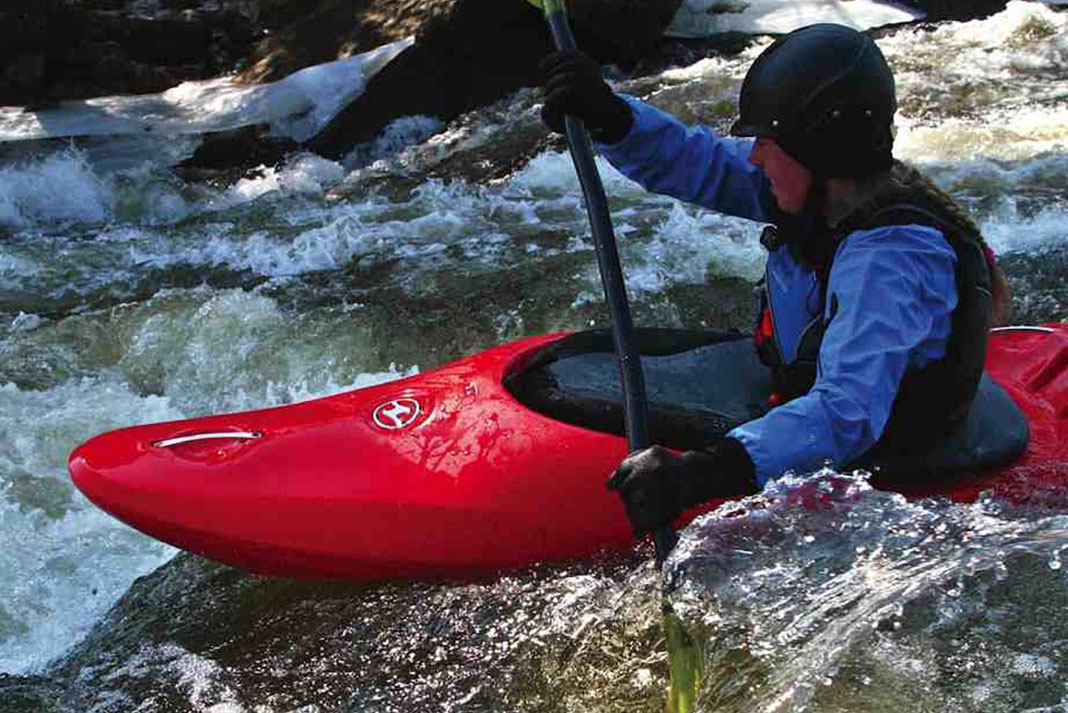Lately it seems like whitewater kayak companies take their marketing cues from the auto industry. The copycat trend had already begun in 2004 when WaveSport hailed its new Diesel 70 river runner as the “SUV of kayaks.” Fortunately, WaveSport left out the stumbling blocks of most SUVs—poor mileage and an unrefined ride—and incorporated only desirable qualities like rugged versatility and voluminous cargo space.
WaveSport Diesel Specs
60 / 70 / 80Length: 7’2” / 7’10” / 8’4”
Width: 24.5” / 25” / 25.8”
Volume: 60 / 70 / 80 U.S. gal
Weight: 38 / 40 / 42 lbs
Paddler: 60–130 / 120–190 / 170–260 lbs
MSRP: $995
www.wavesport.com
Debuting the WaveSport Diesel 70 (and siblings)
Seeking the perfect fit
The Diesels were a huge success and continued to be a top-selling boat for WaveSport into last year. So when WaveSport announced it was overhauling the design for 2009, many fans of the original were apprehensive. Given the popularity and superb handling, outfitting and versatility of the original, “What the hell are they thinking?” seemed a fair question.
What lead designer Robert Peerson was thinking was that by offering more sizing options, he could make the Diesel series the river runners of choice for even more paddlers. By replacing the old 65 and 75 gallon sizes with a 60, 70 and 80 gallon series and coupling these with updated, fully adjustable thigh braces, Peerson has enabled a wider range of paddlers to dial in the perfect fit.
The two original Diesels had huge weight ranges that seemed to work fine for smaller and larger paddlers but left those 160- to 175-pounds in something of a sizing no-man’s-land. These paddlers were well within the weight ranges of both boats, but the 75 had better buoyancy, agility and stability, while the 65 felt more proportionate. The new Diesel 70 is—as Goldilocks would say—just right.
Proven performance on the water
The design team didn’t stop at sizing, however. “After paddling the Diesel and compiling feedback for four years we came up with a few tweaks to improve the design,” Peerson explains. These tweaks included adding a few inches of overall length and increasing the flare on the sidewalls.
Peerson also revamped the rocker profile, softening the transition between the hull and the ends to improve speed and turning. WaveSport team paddler Bryan Kirk tested the Diesel on some West Virginia 20-footers and says the new gradual rocker break also makes for softer landings and easier boofs than the old boat.
If you park the new Diesel next to its predecessor, the 2009 model’s peaked bow and stern deck are among the most striking changes. The original design struggled with resurfacing and water shedding issues in meaty holes and wave trains. This new deck profile allows the Diesel to resurface more predictably and smoothly as well as shed water better when punching holes.
When we reviewed the original Diesel in 2004, we raved about its wicked stability, ease of rolling, impressive cruising speed and uncanny ability to rip long waves. Tearing up swollen creeks this spring, we found the new Diesel is still a pleasure to paddle and a blast to surf. Like a Porsche Cayenne, the Diesel is a chimera with comfortable accessibility that hides a tune-it-out core and makes advancing boaters paddle a class better.
The WaveSport Diesel 70 runs with economy
WaveSport’s claim that the Diesel 70 is the ideal go anywhere, do anything kayak is backed by this river runner’s proven performance on large-volume rivers, creeks and waves. Cash-strapped kayakers (is there any other kind?) will appreciate the Diesel’s versatility and quiver-of-one economy.
Follow us on Instagram @paddlingmagazine.









